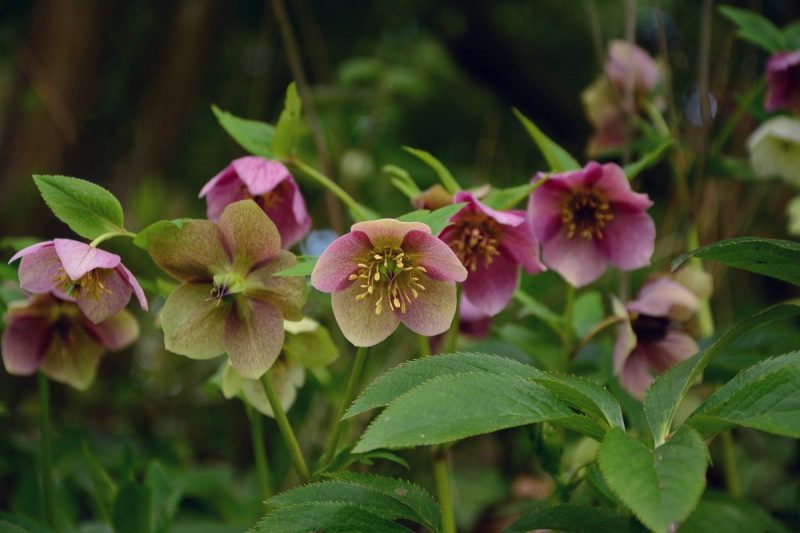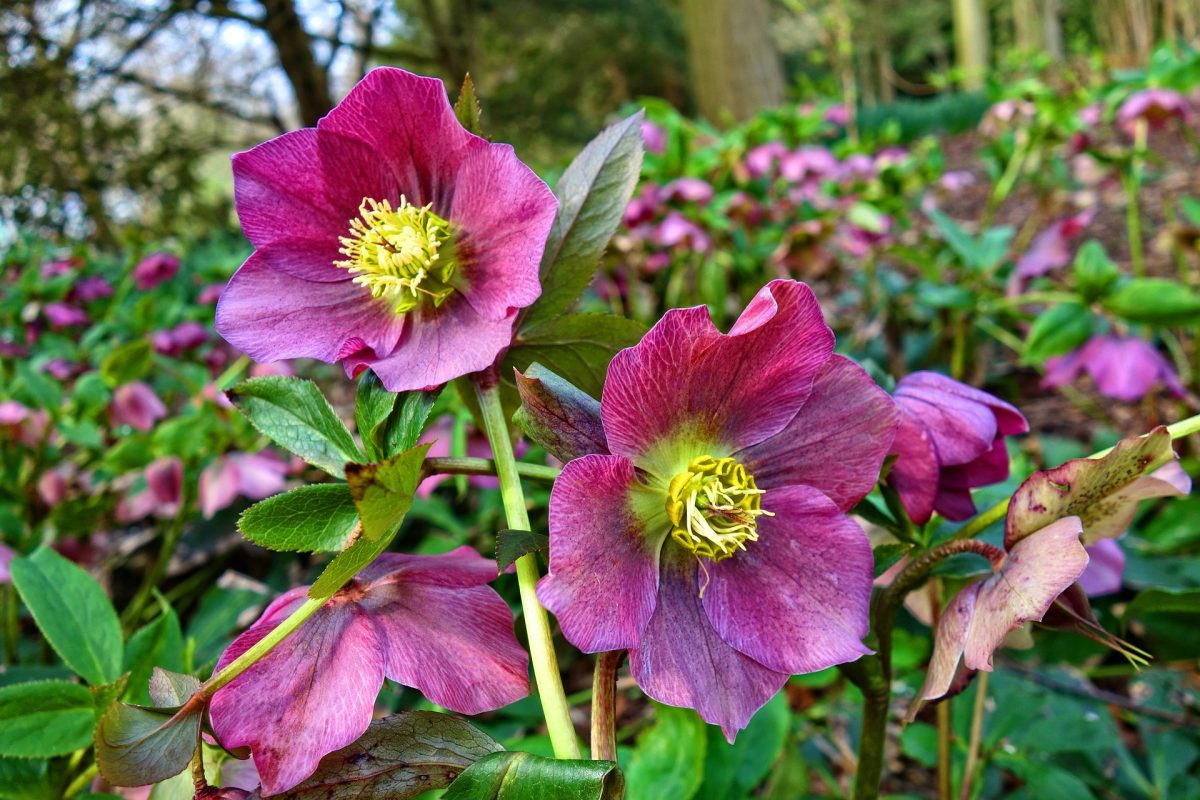Hellebore, planting guide and care work

Hellebore (Helleborus spp.) are perennial, evergreen herbaceous plants that belong to the genus of the same name, and to the Ranunculaceae family. The plants are cultivated due to the palmately, dark green leaves and the large, cup-shaped flowers, composed of 5 sepals similar to the petals, variously colored, which can persist for several months. The petals have evolved over time into short, tubular organs that produce nectar to attract the few insects that are usually around during the flowering period.
Hellebore is often found at the edge of forests, but it can also be grown in the garden, next to borders or in flowerpots, blooming at the end of winter or at the beginning of spring. It keeps its flowers until the middle of spring.
Hellebore – species, hybrids, varieties
- Helleborus orientalis: it bears cup-shaped flowers, in various colors (white, pink, green, purple, purple), blooming starting from the month of February. It grows in the form of a bush, especially in shaded places;
- Helleborus foetidus: bell-shaped, light green flowers. They grow in partial shade, on soils with alkaline pH. They bloom from late winter to mid-spring;
- Helleborus argutifolius: it has straight, upwards-oriented stems, covered with green flowers arranged in bunches, which appear at the end of winter or spring;
- Helleborus niger: with pedunculated dark green leaves and large white or white-pink flowers;
- Helleborus x ballardiae ‘Cinnamon Snow’: with cream-colored flowers. They bloom early, and the appearance of the flowers is not affected by lower outdoor temperatures;
- Helleborus x hybridus Double White Spotted: red spots can be found in the center of the white sepals;
- ‘Anna’s Red’: it has red-purple flowers and leaves with pink ribs. They grow from the end of winter to the middle of spring, in conditions of full or partial shade;
- Winter Jewels ‘Amber Gem’: with very decorative flowers, golden, with a pink border;
- ‘Phillip Ballard’: variety with dark blue, almost black flowers;
- ‘Angel Glow’: with pale pink flowers that turn green as they age;
- ‘Wester Flisk’: these plants have red stems and green flowers, bordered by a red or purple stripe;
- ‘Penny’s Pink’: the flowers are pink with sepals that have red-purple tips.




Hellebore – Environmental conditions
Light. They grow and develop in conditions of partial or total shade, especially during the warm season. In the winter months they need more light. They can be grown in the shade of deciduous trees.
Temperature. Temperature resistance of the plants differs depending on the species/variety. In general, they are tolerant to low temperatures, but the optimal range is: 15-21 ℃.
Soil. They grow and develop on soils rich in organic matter, well drained. It is important that the pH of the soil is neutral or alkaline, as Hellebore does not tolerate acidic soils.
Hellebore – Care
Watering. They prefer medium soil moisture, but mature plants can tolerate drier soil. Excessive moisture and the lack of a good water drainage lead to the rotting of the plants.
Fertilizing. Depending on the fertility of the soil, fertilizers rich in organic substances can be administered. They can be applied in early spring or early autumn.
Recommended products
-
You can find products on a different store
Change Store -
You can find products on a different store
Change Store -
You can find products on a different store
Change Store -
You can find products on a different store
Change Store -
You can find products on a different store
Change Store -
You can find products on a different store
Change Store -
You can find products on a different store
Change Store -
You can find products on a different store
Change Store -
You can find products on a different store
Change Store -
You can find products on a different store
Change Store -
You can find products on a different store
Change Store -
You can find products on a different store
Change Store -
You can find products on a different store
Change Store -
You can find products on a different store
Change Store -
You can find products on a different store
Change Store -
You can find products on a different store
Change Store -
You can find products on a different store
Change Store -
You can find products on a different store
Change Store -
You can find products on a different store
Change Store -
You can find products on a different store
Change Store -
You can find products on a different store
Change Store -
You can find products on a different store
Change Store -
You can find products on a different store
Change Store -
You can find products on a different store
Change Store
Propagation. Hellebore can be propagated by dividing the bush (at the end of winter, before flowering or in autumn) or by seeds.
Diseases and pests – Hellebore
Plants can be affected by various leaf spots or gray mold. Among the pests, aphids, borers or slugs may infest Hellebore.
Recommended products
-
You can find products on a different store
Change Store -
You can find products on a different store
Change Store -
You can find products on a different store
Change Store -
You can find products on a different store
Change Store -
You can find products on a different store
Change Store -
You can find products on a different store
Change Store -
You can find products on a different store
Change Store -
You can find products on a different store
Change Store -
You can find products on a different store
Change Store -
You can find products on a different store
Change Store -
You can find products on a different store
Change Store -
You can find products on a different store
Change Store -
You can find products on a different store
Change Store -
You can find products on a different store
Change Store -
You can find products on a different store
Change Store -
You can find products on a different store
Change Store -
You can find products on a different store
Change Store -
You can find products on a different store
Change Store -
You can find products on a different store
Change Store -
You can find products on a different store
Change Store -
You can find products on a different store
Change Store -
You can find products on a different store
Change Store -
You can find products on a different store
Change Store -
You can find products on a different store
Change Store
Recommended products
-
You can find products on a different store
Change Store -
You can find products on a different store
Change Store -
You can find products on a different store
Change Store -
You can find products on a different store
Change Store -
You can find products on a different store
Change Store -
You can find products on a different store
Change Store -
You can find products on a different store
Change Store -
You can find products on a different store
Change Store -
You can find products on a different store
Change Store -
You can find products on a different store
Change Store -
You can find products on a different store
Change Store -
You can find products on a different store
Change Store -
You can find products on a different store
Change Store -
You can find products on a different store
Change Store -
You can find products on a different store
Change Store -
You can find products on a different store
Change Store -
You can find products on a different store
Change Store -
You can find products on a different store
Change Store -
You can find products on a different store
Change Store -
You can find products on a different store
Change Store -
You can find products on a different store
Change Store -
You can find products on a different store
Change Store -
You can find products on a different store
Change Store -
You can find products on a different store
Change Store
Additionally:
- The administration of fertilizers with a high nitrogen content triggers the vegetative growth period at the expense of flowering;
- Hellebore is considered a slow growing plant;
- Most Hellebore species are toxic to humans and animals;
- The species Helleborus niger is also popularly called Christmas rose.















































































































































































































































































































































































































































